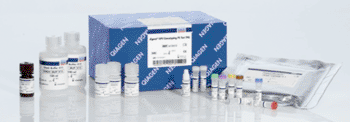Human Papillomavirus Self-Testing Proves Effective
By LabMedica International staff writers
Posted on 06 Feb 2014
Self-testing for human papillomavirus (HPV), which is one of the main causes of cervical cancer, is as effective at detecting cancer as a conventional cytology screening by smear test. Posted on 06 Feb 2014
When self-testing is scaled up to test large populations, the number of women referred to clinics for follow-up tests rapidly increases, but the quality of clinical care then goes down, as clinics are unable to handle the high number of patients.

Image: Hybrid capture assay for human papillomavirus (Photo courtesy of Qiagen).
Scientists from Queen Mary University (London, UK) working with colleagues in Mexico, conducted a pilot study of 100,242 Mexican women aged 25 to 75 and from low-income backgrounds. Around 11% of women tested positive for HPV (10,863 women). The study began in February 2007 and patient follow-up ended in July 2010. The standard Digene conical collection brush (Qiagen Inc.; Gaithersburg, MD, USA) was used to obtain the vaginal specimens.
The High-Risk HPV DNA (hrHPV DNA) was detected with a standard commercial kit employing in vitro nucleic acid hybridization and chemiluminescent microplate-based signal amplification. The Qiagen hybrid capture (HC2) assay was conducted in a validated and accredited routine HPV testing laboratory. The HC2 relative light unit/cutoff of 1 was considered a positive test. The hrHPV positive women and a randomly selected subset of 3.2% of hrHPV negative participants serving as controls were referred to colposcopic examination for diagnosis confirmation.
The hrHPV testing of self-collected vaginal samples demonstrates a high negative predictive value (NPV) for relevant cervical disease, highlighting this test's benefit as a primary screening procedure in developing countries, as women who had a negative hrHPV result have virtually no risk of cervical intraepithelial neoplasia (CIN) 3+ lesions. Self-collected hrHPV testing may be particularly attractive for increasing screening intervals, and it appears to be an acceptable screening option in large-scale routine settings. In addition, given the magnitude of the relative risk and positive likelihood ratio, the findings demonstrate that hrHPV testing of self-collected samples is a satisfactory screening test for identification of women with target CIN2+ lesions.
Attila T. Lorincz, PhD, a professor of molecular epidemiology and lead author, said, “Our findings show that large-scale HPV screening can be successfully implemented by home testing. However, if a positive result is received, it's imperative that all other follow-up services are strengthened so they can accommodate the big increase in screened women. This is one of the huge challenges we face in developing countries like Mexico and will continue to work on.” The study was published on December 7, 2013, in the International Journal of Cancer.
Related Links:
Queen Mary University
Qiagen Inc.




 assay.jpg)



 (3) (1).png)




